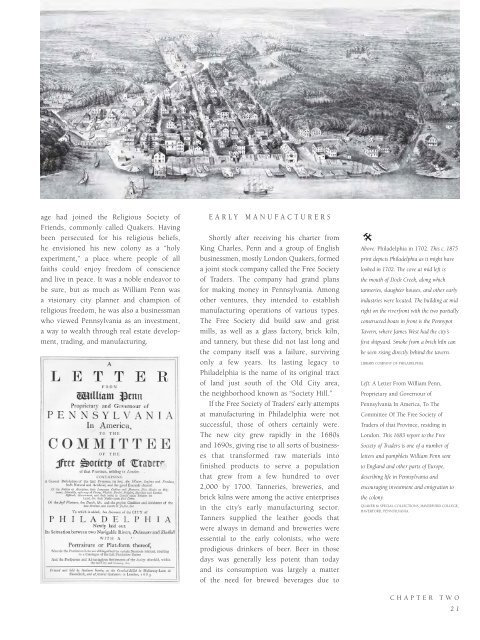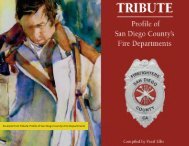In The Cradle of Industry and Liberty
An illustrated history of Philadelphia's manufacturing sector paired with the histories of local companies that make the city great.
An illustrated history of Philadelphia's manufacturing sector paired with the histories of local companies that make the city great.
Create successful ePaper yourself
Turn your PDF publications into a flip-book with our unique Google optimized e-Paper software.
age had joined the Religious Society <strong>of</strong><br />
Friends, commonly called Quakers. Having<br />
been persecuted for his religious beliefs,<br />
he envisioned his new colony as a “holy<br />
experiment,” a place where people <strong>of</strong> all<br />
faiths could enjoy freedom <strong>of</strong> conscience<br />
<strong>and</strong> live in peace. It was a noble endeavor to<br />
be sure, but as much as William Penn was<br />
a visionary city planner <strong>and</strong> champion <strong>of</strong><br />
religious freedom, he was also a businessman<br />
who viewed Pennsylvania as an investment,<br />
a way to wealth through real estate development,<br />
trading, <strong>and</strong> manufacturing.<br />
EARLY<br />
MANUFACTURERS<br />
Shortly after receiving his charter from<br />
King Charles, Penn <strong>and</strong> a group <strong>of</strong> English<br />
businessmen, mostly London Quakers, formed<br />
a joint stock company called the Free Society<br />
<strong>of</strong> Traders. <strong>The</strong> company had gr<strong>and</strong> plans<br />
for making money in Pennsylvania. Among<br />
other ventures, they intended to establish<br />
manufacturing operations <strong>of</strong> various types.<br />
<strong>The</strong> Free Society did build saw <strong>and</strong> grist<br />
mills, as well as a glass factory, brick kiln,<br />
<strong>and</strong> tannery, but these did not last long <strong>and</strong><br />
the company itself was a failure, surviving<br />
only a few years. Its lasting legacy to<br />
Philadelphia is the name <strong>of</strong> its original tract<br />
<strong>of</strong> l<strong>and</strong> just south <strong>of</strong> the Old City area,<br />
the neighborhood known as “Society Hill.”<br />
If the Free Society <strong>of</strong> Traders’ early attempts<br />
at manufacturing in Philadelphia were not<br />
successful, those <strong>of</strong> others certainly were.<br />
<strong>The</strong> new city grew rapidly in the 1680s<br />
<strong>and</strong> 1690s, giving rise to all sorts <strong>of</strong> businesses<br />
that transformed raw materials into<br />
finished products to serve a population<br />
that grew from a few hundred to over<br />
2,000 by 1700. Tanneries, breweries, <strong>and</strong><br />
brick kilns were among the active enterprises<br />
in the city’s early manufacturing sector.<br />
Tanners supplied the leather goods that<br />
were always in dem<strong>and</strong> <strong>and</strong> breweries were<br />
essential to the early colonists, who were<br />
prodigious drinkers <strong>of</strong> beer. Beer in those<br />
days was generally less potent than today<br />
<strong>and</strong> its consumption was largely a matter<br />
<strong>of</strong> the need for brewed beverages due to<br />
@<br />
Above: Philadelphia in 1702. This c. 1875<br />
print depicts Philadelphia as it might have<br />
looked in 1702. <strong>The</strong> cove at mid left is<br />
the mouth <strong>of</strong> Dock Creek, along which<br />
tanneries, slaughter houses, <strong>and</strong> other early<br />
industries were located. <strong>The</strong> building at mid<br />
right on the riverfront with the two partially<br />
constructed boats in front is the Pennypot<br />
Tavern, where James West had the city’s<br />
first shipyard. Smoke from a brick kiln can<br />
be seen rising directly behind the tavern.<br />
LIBRARY COMPANY OF PHILADELPHIA.<br />
Left: A Letter From William Penn,<br />
Proprietary <strong>and</strong> Governour <strong>of</strong><br />
Pennsylvania <strong>In</strong> America, To <strong>The</strong><br />
Committee Of <strong>The</strong> Free Society <strong>of</strong><br />
Traders <strong>of</strong> that Province, residing in<br />
London. This 1683 report to the Free<br />
Society <strong>of</strong> Traders is one <strong>of</strong> a number <strong>of</strong><br />
letters <strong>and</strong> pamphlets William Penn sent<br />
to Engl<strong>and</strong> <strong>and</strong> other parts <strong>of</strong> Europe,<br />
describing life in Pennsylvania <strong>and</strong><br />
encouraging investment <strong>and</strong> emigration to<br />
the colony.<br />
QUAKER & SPECIAL COLLECTIONS, HAVERFORD COLLEGE,<br />
HAVERFORD, PENNSYLVANIA.<br />
CHAPTER TWO<br />
21
















